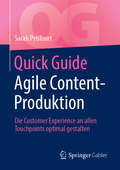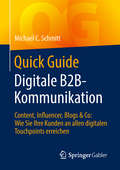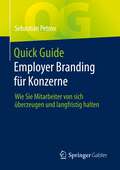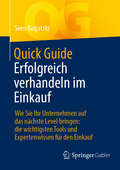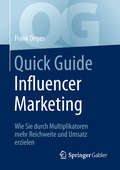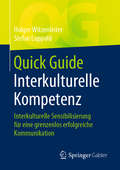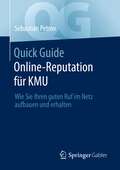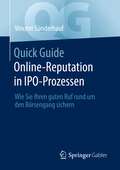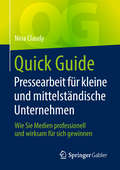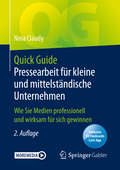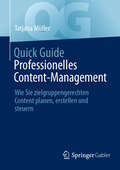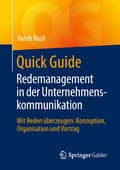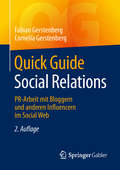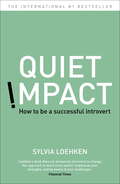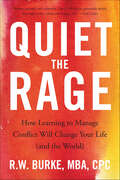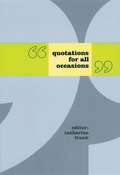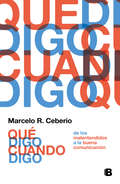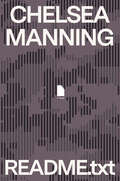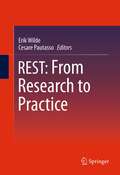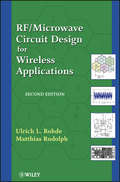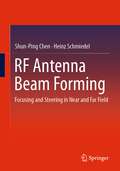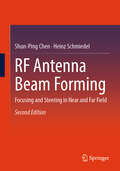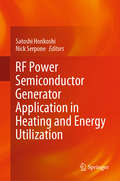- Table View
- List View
Quick Guide Agile Content-Produktion: Die Customer Experience An Allen Touchpoints Optimal Gestalten (Quick Guide)
by Sarah PetifourtDynamisch und nach personalisiertem Mehrwert suchend – so entwickelt sich unser derzeitiges Kommunikationsverhalten. Gleichzeitig werden Marken für Konsumenten immer wichtiger, obgleich deren Produkte nicht mehr einzigartig, sondern nahezu austauschbar sind. Neben neuen Ideen und nutzwertigen Inhalten sind mittlerweile auch strukturelle und technische Raffinessen notwendig, um Konsumenten zu erreichen. Zielführender Content – das heißt wirklich jede inhaltliche Botschaft, die ein Unternehmen kommuniziert – muss daher zu einem unverzichtbaren Tool in den Unternehmen werden. Aber wie produziert und steuert man diesen am besten? Die Antwort lautet: agil! Dieses Buch erklärt kompakt und fundiert, welche herausragende Bedeutung Content heute hat und wie agile Methoden für die Produktion von zielgruppenspezifischen Inhalten angewendet werden können, um potenzielle Kunden im entscheidenden Moment an allen Touchpoints digital abzuholen und langfristig zu binden. Ein nützliches Buch mit zahlreichen anschaulichen Beispielen, Transferaufgaben und Fragestellungen, die Ihnen die Anwendung in der Praxis erleichtern.
Quick Guide Content Marketing für den B2B-Mittelstand: Wie KMU mehr Sichtbarkeit im Markt bekommen (Quick Guide)
by Uwe KleinkesContent Marketing ist in der heutigen digitalen Zeit ein wichtiges und erfolgsentscheidendes Werkzeug – und nicht nur großen Unternehmen vorbehalten. Auch kleinere Unternehmen mit B2B-Zielgruppen können Content Marketing gewinnbringend einsetzen.Dieser Quick Guide unterstützt mittelständische B2B-Unternehmen dabei, mittels Content-Marketing-Maßnahmen mehr Sichtbarkeit im Markt zu bekommen als ihre Wettbewerber. Das Buch erklärt alle grundlegenden Schritte, von Zielbestimmung über Analyse, Planung, Produktion und Management der Maßnahmen, und geht dabei auf die Besonderheiten im B2B-Markt ein.Marketing-Praktiker, die wenig Zeit und Vorkenntnisse haben, erhalten einen schnellen, grundlegenden Einblick sowie pragmatische Hilfestellungen für die Umsetzung. Ergänzend stellen Experten aus der Praxis ihre konkreten Projekte und Erfahrungen vor.Mit zahlreichen Checklisten zu einem organisierten, schrittweisen Vorgehen, umfangreichem weiterführendem Online-Arbeitsmaterial und Transferaufgaben für die individuelle Praxis.
Quick Guide Digitale B2B-Kommunikation: Content, Influencer, Blogs & Co: Wie Sie Ihre Kunden an allen digitalen Touchpoints erreichen (Quick Guide)
by Michael C. SchmittDieses Buch gibt einen kompakten Überblick über alle digitalen Kommunikationskanäle, die B2B-Unternehmen zielgerichtet für sich nutzen können, um Kunden auch in Zukunft auf sich aufmerksam zu machen, sie zu gewinnen und zu binden.Der Autor beschreibt, wie B2B-Unternehmen Content Marketing und Online-PR für sich nutzen, warum Videos hilfreiche Werkzeuge sind und welche Rolle Influencer bei der Ansprache von Business-Zielgruppen spielen. Er erklärt, wie Suchmaschinenoptimierung (SEO) funktioniert und welchen Regeln Social Media, Word of Mouth oder Unternehmensblogs unterliegen.Machen auch Sie einen Reality-Check Ihres Unternehmens und finden Sie heraus, mit welchen Kommunikationsmaßnahmen Ihr Unternehmen nachhaltig in Kontakt mit der Zielgruppe treten kann. Ein direkt anwendbares Buch, das Sie mit Transferübungen und Fragen für die Zukunft rüsten und inspirieren soll.
Quick Guide Employer Branding für Konzerne: Wie Sie Mitarbeiter von sich überzeugen und langfristig halten (Quick Guide)
by Sebastian PetrovDieses Buch erläutert kompakt und auf den Punkt, warum Konzerne heute eine Employer-Branding-Strategie brauchen, und wie sie die besten Fachkräfte am Markt von sich überzeugen und halten. Das Ziel: eine emotionale Verbundenheit der Mitarbeiter zu ihrem Unternehmen herzustellen, die auch in eventuellen Krisenzeiten Bestand hat. Diese Verbundenheit führt zu motivierten Mitarbeitern, die sich mit ihrem Arbeitsplatz identifizieren oder sogar als Multiplikatoren fungieren und damit das Recruiting im War for Talents unterstützen. Der Autor erläutert alle wichtigen Basics, liefert wertvolle Impulse und gibt Antworten auf die Fragen: Welche internen und externen Gründe sprechen für ein gezieltes Employer Branding? Welchen Fragen muss man sich stellen, um den Ist-Zustand zu ermitteln? Was ist eine Employer Value Proposition? Und: Wie sollte eine optimale Candidate Journey aussehen? Ein Buch für alle Geschäftsführer, Personal- und Marketingverantwortlichen in Großunternehmen, die eine starke Employer Brand schaffen wollen.
Quick Guide Erfolgreich verhandeln im Einkauf: Wie Sie Ihr Unternehmen auf das nächste Level bringen: die wichtigsten Tools und Expertenwissen für den Einkauf (Quick Guide)
by Sven BogatzkiDer Druck für Unternehmen durch schleppende Wirtschaftsentwicklung, sinkende Kaufkraft und absoluter Preistransparenz wird immer größer. Mehr denn je liegt im Einkauf der entscheidende Hebel, um sich in diesem schwierigen Marktumfeld zu behaupten. Sven Bogatzki ist Einkaufsexperte und führt seit über 25 Jahren Teams, Abteilungen und Unternehmen von einem Erfolg zum nächsten. In "Boost! Bringe deinen Einkauf auf ein neues Level" greift er auf diese Erfahrungen zurück und zeigt entscheidende Ansätze und Methoden, um den Einkauf in Unternehmen zu optimieren – mit enormem Fachwissen, praxisnah, authentisch und ganz persönlich.
Quick Guide Influencer Marketing: Wie Sie durch Multiplikatoren mehr Reichweite und Umsatz erzielen (Quick Guide)
by Frank DegesAuthentische und persönliche Werbebotschaften werden im Kaufprozess immer wichtiger. Dieser Quick Guide erklärt kompakt und auf den Punkt, wie Unternehmen erfolgreich mit Influencern zusammenarbeiten können. Denn: Erfolgreiche Influencer haben sich in den Sozialen Netzwerken in den letzten Jahren als glaubwürdige Meinungsführer und Markenbotschafter mit hoher Reichweite, Relevanz und Resonanz etabliert. Ihre Blogs, Instagram-Accounts oder YouTube-Kanäle sind attraktive Marketinginstrumente für zahlreiche Branchen geworden.Der Autor vermittelt die Grundlagen des Influencer Marketings und zeigt Schritt für Schritt auf, was Unternehmen tun müssen, um ihre individuelle Influencer-Strategie zu entwickeln: von der Zielgruppen- und Kanalbestimmung über die Auswahl der richtigen Influencer bis hin zu Vertragsverhandlungen, Kampagnenmanagement und Monitoring.
Quick Guide Interkulturelle Kompetenz: Interkulturelle Sensibilisierung für eine grenzenlos erfolgreiche Kommunikation (Quick Guide)
by Stefan Luppold Holger WitzenleiterDieser Quick Guide erklärt die Hintergründe einer oftmals schwierigen interkulturellen Kommunikation und zeigt anhand von Modellen auf, wie man bestimmten Kommunikationsfallen entkommen kann. Anhand von fünf Beispielen werden misslungene interkulturelle Projekte zwischen Deutschland und seinen wichtigsten Wirtschaftspartnern analysiert und es wird erläutert, wie ein kulturadäquater Austausch hätte aussehen müssen.Dabei beschreiben die Autoren anschaulich, wie wichtig die Beschäftigung mit der eigenen Kultur ist und aus welchen verschiedenen Teilkompetenzen interkulturelle Kompetenz besteht.Um diese Teilfertigkeiten zu erlangen, geben die Autoren jeweils kleine Übungen vor. Abgerundet wird dieser Quick Guide mit Empfehlungen, wie der Leser das Gelernte in den Alltag übernehmen kann. Das Buch richtet sich an Personen, die im internationalen Kontext arbeiten, wie auch an Personal-Entwickler, die ihre Teams für Meetings, Events und Projekte auswählen und schulen. Aus dem Inhalt Was ist Interkulturelle Kompetenz? Wahrnehmung, Wahrnehmungsfilter und StereotypenHilfreiche Kommunikationsmodelle und KommunikationsstrategienKulturstandards in China, Großbritannien, Frankreich, der Schweiz und den USAFallbeispiele für misslungene und gelungene Kommunikation
Quick Guide Online-Reputation für KMU: Wie Sie Ihren guten Ruf im Netz aufbauen und erhalten (Quick Guide)
by Sebastian PetrovDieses Buch gibt einen kompakten Einblick in die Grundlagen des Online-Reputationsmanagements und zeigt auf, warum es für jedes Unternehmen unabhängig von der Größe unverzichtbar ist, sich aktiv um seinen guten Ruf zu kümmern. Denn neben physischen Gütern prägen heute auch die immateriellen Werte das Image eines Unternehmens ganz entscheidend.Angriffe auf das Image drohen von allen Seiten – durch falsche Berichte, Cyberangriffe, Shitstorms oder Fake News. Sie können aber auch selbstverschuldet sein, wenn ein Unternehmen zum Beispiel schlechte Qualität oder einen miserablen Kundenservice bietet. Der beste Zeitpunkt, sich um die eigene Reputation zu kümmern, ist dann, wenn sie noch keinen Schaden erlitten hat. Dabei hilft dieser Quick Guide. Aber auch diejenigen, die sich schon im akuten Krisenmanagement befinden, werden durch dieses Buch wertvolle Impulse bekommen, um ihre Reputation wiederherzustellen.
Quick Guide Online-Reputation in IPO-Prozessen: Wie Sie Ihren guten Ruf rund um den Börsengang sichern (Quick Guide)
by Vincent SünderhaufIn diesem Buch erfahren Sie kompakt und auf den Punkt aufbereitet, warum ein professionelles Reputationsmanagement in den unterschiedlichen Phasen eines Börsengangs so wichtig ist und welche Möglichkeiten es gibt, die Unternehmensreputation in diesem Prozess aktiv zu steuern. Denn Reputation ist gerade bei börsennotierten Unternehmen ein sensibles Thema und ein wesentlicher Erfolgsfaktor, der sich direkt in Gewinne umrechnen lässt. Sie bildet sich auch ohne das Zutun eines Unternehmens – in Bewertungen, Medien- und Presseberichten oder über die Social-Media-Kanäle. Insbesondere im Rahmen von IPOs (Initial Public Offerings) sind Unternehmen sehr präsent in der öffentlichen Wahrnehmung und einer öffentlichen Meinungsäußerung stärker ausgesetzt. Umso wichtiger ist es, die Risiken zu kennen, um gezielt Argumente vorzubereiten und vorausschauend ein gutes Krisenmanagement zu etablieren. Ein kompakter Leitfaden, der die Grundlagen und Herausforderungen erläutert und anhand von Beispielen veranschaulicht, worauf zu achten ist.
Quick Guide Pressearbeit für kleine und mittelständische Unternehmen
by Nina ClaudyDieses Buch ist eine kompakte Einführung in alle erfolgsentscheidenden Aspekte der Pressearbeit konkret für den Mittelstand. Nützlicher Content, aktuelle Themen, gut aufbereitete Infos und zielführende Wissensvermittlung werden von Redaktionen und Journalisten stets dankbar angenommen und veröffentlicht. Nina Claudy zeigt in ihrem Buch, wie Sie vorgehen müssen, um die Presse effektiv zu erreichen.Von der Konzeption über verschiedene Handlungsfelder, Instrumente, Kanäle und die konkrete Zielgruppenarbeit bis hin zu Maßnahmen, Evaluation und Umgang mit Dienstleistern – dieser Quick Guide deckt alles ab, was Verantwortliche in KMU für die Arbeit mit den Medien beachten müssen.Ein pragmatischer Leitfaden für die tägliche Anwendung in der Praxis, der Ihnen helfen wird, eine Strategie und einen konkret umsetzbaren Plan für Ihre Pressearbeit zu entwickeln. Mit zahlreichen Beispielen und Transferaufgaben.
Quick Guide Pressearbeit für kleine und mittelständische Unternehmen: Wie Sie Medien professionell und wirksam für sich gewinnen (Quick Guide)
by Nina ClaudyDieses Buch ist eine kompakte Einführung in alle erfolgsentscheidenden Aspekte der Pressearbeit konkret für den Mittelstand. Nützlicher Content, aktuelle Themen, gut aufbereitete Infos und zielführende Wissensvermittlung werden von Redaktionen und Journalisten stets dankbar angenommen und veröffentlicht. Nina Claudy zeigt in ihrem Buch, wie Sie vorgehen müssen, um die Presse effektiv zu erreichen.Von der Konzeption über verschiedene Handlungsfelder, Instrumente, Kanäle und die konkrete Zielgruppenarbeit bis hin zu Maßnahmen, Evaluation und Umgang mit Dienstleistern – dieser Quick Guide deckt alles ab, was Verantwortliche in KMU für die Arbeit mit den Medien beachten müssen.Ein pragmatischer Leitfaden für die tägliche Anwendung in der Praxis, der Ihnen helfen wird, eine Strategie und einen konkret umsetzbaren Plan für Ihre Pressearbeit zu entwickeln. Mit zahlreichen Beispielen und Transferaufgaben.Neu in der aktualisierten zweiten Auflage: Testen Sie Ihr Wissen mit den exklusiven Fragen und Antworten zum Buch in der kostenlosen Springer-Nature-Flashcards-App.
Quick Guide Professionelles Content-Management: Wie Sie zielgruppengerechten Content planen, erstellen und steuern (Quick Guide)
by Tatjana MüllerDieses kompakte Buch zeigt, was professionelles Content-Management und Content-Marketing ausmacht, welchen Zweck es für Unternehmen erfüllt und wie eine erfolgreiche Content-Strategie aufgebaut wird. Tatjana Müller fasst ihre Erfahrungen zusammen, die sie über Jahre als Redakteurin, Texterin und Content-Managerin gesammelt hat. Dabei erläutert sie nicht nur die Aufgaben und Verantwortungsbereiche von Content-Manager*innen, sondern bietet auch zahlreiche Tipps aus der Praxis. Dieser Quick Guide richtet sich an alle, die als Content-Manager*innen tätig sind oder sein wollen und kreative, nutzwertige Inhalte für unterschiedliche Zielgruppen erstellen möchten. Außerdem spricht er alle an, die im Rahmen ihrer Tätigkeit als Führungskraft mit Content-Manager*innen zu tun haben.
Quick Guide Redemanagement in der Unternehmenskommunikation: Mit Reden überzeugen: Konzeption, Organisation und Vortrag (Quick Guide)
by Vazrik BazilDieses Buch richtet sich an alle, die ihrem Unternehmen oder ihrer Organisation zu einem erfolgreichen Auftritt verhelfen wollen, sei es als Redner, Redenschreiber oder Kommunikationsverantwortlicher. Es zeigt kurz und kompakt auf, wie ein gelungenes Redemanagement zentrale Knotenpunkte – Konzeption, Niederschrift, Vortrag und Organisation der Redeproduktion – optimal miteinander verknüpft. Der Autor erklärt die Grundlagen eines erfolgreichen Redemanagements, mit deren Hilfe die Rede als wirkungsvolles Kommunikationsinstrument eingesetzt werden kann: von der Idee über die Anordnung der Inhalte und die konkreten Formulierungen bis hin zu Gedächtnisübungen und dem eigentlichen Auftritt. Erstmalig erläutert der Autor auch die Funktionsweise von Crowd-Ghostwriting, eine von ihm erfundene Methode der Redeproduktion. Zudem regt er wertvolle Übungen an und gibt inspirierende Denkanstöße für Ihre Redepraxis.
Quick Guide Social Relations: PR-Arbeit mit Bloggern und anderen Influencern im Social Web (Quick Guide)
by Fabian Gerstenberg Cornelia GerstenbergDieses Buch zeigt, wie PR-Schaffende erfolgreich mit Bloggern und anderen einflussreichen Akteuren des Social Webs interagieren können. Die Autoren bieten in diesem Quick Guide einen schnellen und direkt anwendbaren Zugang zu den neuen Kommunikationsregeln im Internet, konkrete Handlungsempfehlungen für Blogger Relations und zielgerichtete Impulse, um die Öffentlichkeitsarbeit mit reichweitenstarken Multiplikatoren und Influencern im Netz professionell zu optimieren. Außerdem: Erfolgreiche Blogger geben Branchen-Insights und erklären, wie man gut mit ihnen ins Gespräch kommt.Neu in der aktualisierten 2. Auflage: Zahlreiche Transferübungen für die direkte Anwendung in der Praxis.
Quiet Impact: How to be a successful Introvert
by Sylvia LoehkenMost literature on business, communication and success is focused on extroverts, who feel comfortable networking, talking and being the centre of attention. But at least 30% of the population are introverts, and they are now finding their voice. Quiet Impact - How to Be a Successful Introvert is already an international phenomenon. Using the latest psychological research, and Dr Loehken's own extensive experience coaching introverts in the workplace, it is packed with practical advice which is easy to implement. Dr Loehken identifies 10 strengths specific strengths that introverts often have (such as independence, perseverance and writing), and also identifies ten specific hurdles they often have to overcome (such as hyperstimulation, intellectualism and fear of conflict).
Quiet Impact: How to be a successful Introvert
by Sylvia LoehkenMost literature on business, communication and success is focused on extroverts, who feel comfortable networking, talking and being the centre of attention. But at least 30% of the population are introverts, and they are now finding their voice.Quiet Impact - How to Be a Successful Introvert is already an international phenomenon. Using the latest psychological research, and Dr Loehken's own extensive experience coaching introverts in the workplace, it is packed with practical advice which is easy to implement.Dr Loehken identifies 10 strengths specific strengths that introverts often have (such as independence, perseverance and writing), and also identifies ten specific hurdles they often have to overcome (such as hyperstimulation, intellectualism and fear of conflict).
Quiet the Rage: How Learning to Manage Conflict Will Change Your Life (and the World)
by R.W. BurkeIn a world with more than 7 billion people, 196 countries, 7,000 spoken languages, and close to 30 religions, the probability of one group or one person intentionally or unintentionally offending another group or another person is absolutely certain. Many people limit themselves in life based on their inability to get along with others, and too often we allow ourselves to be ruled by our emotions. When we’re emotionally reactive, we’re not our best selves, nor do we produce the smartest outcomes. Emotional reactions create winners and losers. And winning directly at the expense of another is actually losing in disguise, due to the resentment it inspires in the loser. Often, people get stuck in a pattern of reacting emotionally, long past the time when the combativeness that once served them no longer does; long past the time when the pattern has become destructive without them being aware of it. For everyone who wants to change that part of themselves—everyone who wants more peaceful interactions and more successful outcomes, but doesn’t know how to achieve that—Quiet the Rage is the answer.
Quotations for All Occasions
by Catherine FrankOn the most important occasions of our lives, we often find ourselves at a loss for words; when we want to console, celebrate, explain, inspire, or thank, we end up repeating such uninspiring, uninformative phrases as "Words cannot express how I feel." To help us find the right words, Catherine Frank has compiled this handy compendium of quotations that capture the mundane and the magnificent, the everyday and extraordinary moments of our lives.The three sections of the book cover 150 occasions. "Every Year" offers quotations on all the special dates in the calendar from New Year's Day to New Year's Eve, including Martin Luther King Day, Valentine's Day, Ramadan, Mother's Day, Thanksgiving, Kwanzaa, and Christmas. "Occasionally" presents quotations on such occasions as giving a speech, having an interview, becoming a parent, getting engaged, welcoming someone, and saying goodbye. "Once in a Lifetime" provides quotations on such momentous events as confirmation, coming out, turning 16, graduation, and retirement. A sampling: Plato, John Donne, and Woody Allen give their words of wisdom on death. Betty Ford writes eloquently on recovery. Martina Navratilova ruminates on her first sexual encounter... and Holden Caufield on his. Ralph Waldo Emerson, Mark Twain, and Frederick Douglass ponder Independence Day. Amy Tan reflects on the meaning of the Chinese New Year. Samuel Taylor Coleridge and Susan Sontag offer poignant descriptions of pain and illness.Whether you are offering consolation or congratulations, condolences or confessions, Quotations for All Occasions has the perfect words for every occasion.
Qué digo cuando digo: De los malentendidos a la buena comunicación
by Marcelo R. CeberioUna guía indispensable para mejorar tu mundo social, emocional, laboral e interpersonal y para potenciar tus recursos y fortalezas. A menudo no somos conscientes de lo importante que es comunicarse de manera clara, evitando malentendidos y confusiones. De ahí que, frecuentemente, no demos crédito al impacto de nuestras palabras, gestos o actitudes y, a su vez, al efecto que nos causa lo que transmite nuestro interlocutor. De lectura ágil y clara, Qué digo cuando digo. De los malos entendidos a la buena comunicación, es un libro que explica la comunicación humana y, a la vez, trata de reflexionar acerca de ella. Si el lector comprendió su contenido, logrará hacerse más responsable del grado de influencia que ejercemos las personas mediante la comunicación. Respetará más la palabra del otro y entenderá qué implica ser libre en ese maravilloso juego cuando dos personas comienzan a comunicarse. «Recomiendo calurosamente el libro de mi amigo, el Dr. Marcelo R. Ceberio. Una guía indispensable para mejorar tu mundo social, emocional, laboral e interpersonal y para potenciar tus recursos y fortalezas.»Bernardo Stamateas
README.txt: A Memoir
by Chelsea ManningAn intimate, revealing memoir from one of the most important activists of our time. In 2010, Chelsea Manning, working as an intelligence analyst in the United States Army in Iraq, disclosed classified military documents that she had smuggled out via the memory card of her digital camera. The army sentenced Manning to thirty-five years in military prison, charging her with twenty-two counts relating to the unauthorized possession and distribution of classified military documents. The day after her conviction, Manning declared her gender identity as a woman and began to transition. In 2017, President Barack Obama commuted her sentence and she was released from prison. In README.txt, Manning recounts how her pleas for increased institutional transparency and government accountability took place alongside a fight to defend her rights as a trans woman. She reveals her challenging childhood, her struggles as an adolescent, what led her to join the military, and the fierce pride she took in her work. We also learn the details of how and why she made the decision to send classified military documents to WikiLeaks. This powerful, observant memoir will stand as one of the definitive testaments of the digital age.
REST: From Research to Practice
by Cesare Pautasso Erik WildeThis volume provides an overview and an understanding of REST (Representational State Transfer). Discussing the constraints of REST the book focuses on REST as a type of web architectural style. The focus is on applying REST beyond Web applications (i.e., in enterprise environments), and in reusing established and well-understood design patterns when doing so. The reader will be able to understand how RESTful systems can be designed and deployed, and what the results are in terms of benefits and challenges encountered in the process. Since REST is relatively new as an approach for designing Web Services, the more advanced part of the book collects a number of challenges to some of the assumptions and constraints of REST, and looks at current research work on how REST can be extended and applied to scenarios that often are considered not to be a good match for REST. This work will help readers to reach a deeper understanding of REST on a practical as well as on an advanced level.
RF / Microwave Circuit Design for Wireless Applications
by Ulrich L. Rohde Matthias RudolphProvides researchers and engineers with a complete set of modeling, design, and implementation tools for tackling the newest IC technologiesRevised and completely updated, RF/Microwave Circuit Design for Wireless Applications, Second Edition is a unique, state-of-the-art guide to wireless integrated circuit design that provides researchers and engineers with a complete set of modeling, design, and implementation tools for tackling even the newest IC technologies. It emphasizes practical design solutions for high-performance devices and circuitry, incorporating ample examples of novel and clever circuits from high-profile companies.Complete with excellent appendices containing working models and CAD-based applications, this powerful one-stop resource:Covers the entire area of circuit design for wireless applicationsDiscusses the complete system for which circuits are designed as well as the device technologies on which the devices and circuits are basedPresents theory as well as practical issuesIntroduces wireless systems and modulation typesTakes a systematic approach that differentiates between designing for battery-operated devices and base-station designRF/Microwave Circuit Design for Wireless Applications, Second Edition is an indispensable tool for circuit designers; engineers who design wireless communications systems; and researchers in semiconductor technologies, telecommunications, and wireless transmission systems.
RF Antenna Beam Forming: Focusing and Steering in Near and Far Field
by Shun-Ping Chen Heinz SchmiedelThis book is designed for both the scientific audience, research and development engineers and the university students. The fundamentals of radio frequency antenna beam forming is explained in this book. The principles of beam focusing and beam steering in near field and far field are visualized with 2D and 3D simulations and compared with measurement results. Besides linear and planar antenna arrays, also conformal arrays, i.e. concave and convex antenna arrays, suitable for certain applications, are investigated and presented. Also related applications of radio frequency beam forming like open loop and closed loop large scale antenna arrays or massive MIMO, which is one of the break-through technologies for 5G and future 6G and involves an extremely large number of antenna elements for the multi-user beam forming, as well as thinned antenna arrays with electrically large distances between the antenna elements are discussed.
RF Antenna Beam Forming: Focusing and Steering in Near and Far Field
by Shun-Ping Chen Heinz SchmiedelThis book is designed for both the scientific audience, research and development engineers and university students. The fundamentals of radio frequency antenna beam forming are explained in this book. The principles of beam focusing and beam steering in near field and far field are visualized with 2D and 3D simulations and compared with measurement results. Besides linear and planar antenna arrays, also conformal arrays, i.e. concave and convex antenna arrays, suitable for certain applications, are investigated and presented. Also related applications of open loop and closed loop beam forming, and massive MIMO, which is one of the break-through technologies for 5G and future 6G and involves an extremely large number of antenna elements for the multi-user beam forming, are discussed in detail. Also covered are large scale antenna arrays as well as thinned antenna arrays with electrically large distances between the antenna elements.
RF Power Semiconductor Generator Application in Heating and Energy Utilization
by Nick Serpone Satoshi HorikoshiThis is a specialized book for researchers and technicians of universities and companies who are interested in the fundamentals of RF power semiconductors, their applications and market penetration.Looking around, we see that products using vacuum tube technology are disappearing. For example, branch tube TVs have changed to liquid crystal TVs, and fluorescent light have turned into LED. The switch from vacuum tube technology to semiconductor technology has progressed remarkably. At the same time, high-precision functionalization, miniaturization and energy saving have advanced. On the other hand, there is a magnetron which is a vacuum tube device for generating microwaves. However, even this vacuum tube technology has come to be replaced by RF power semiconductor technology. In the last few years the price of semiconductors has dropped sharply and its application to microwave heating and energy fields will proceed. In some fields the transition from magnetron microwave oscillator to semiconductor microwave oscillator has already begun. From now on this development will progress remarkably. Although there are several technical books on electrical systems that explain RF power semiconductors, there are no books yet based on users' viewpoints on actual microwave heating and energy fields. In particular, none have been written about exact usage and practical cases, to answer questions such as "What are the advantages and disadvantages of RF power semiconductor oscillator?", "What kind of field can be used?" and the difficulty of the market and application. Based on these issues, this book explains the RF power semiconductors from the user's point of view by covering a very wide range of fields.
